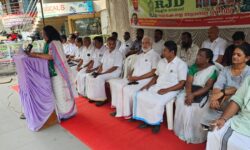KOCHI:
Growing up in south Kerala eight decades ago, A Ramachandran once happened to see a pot-seller woman make a quick figure from clay. That was when the aged vendor, familiar to the family, gave the little boy a lump of red earth upon his mother’s suggestion.
“Just before that, the woman rolled some clay between her palms. The clod gained length…vertically. Then she flattened its top to make it look like a human face. On to that round, she stuck two red-lucky seeds. Eyes, you know,” the renowned artist recalls, in a throwback to his first exposure to sculpting. “That minimalist image came back to me three years ago.”
The context for the recall of that childhood incident is a 2016 metal work of Mahatma Gandhi by Delhi-based Ramachandran, who is currently holding an exhibition in his native state. The seven-foot-tall bronze sculpture is on display at the Durbar Hall Art Gallery here, as part of the milestone show by the 84-year-old master.
Titled ‘The Mahatma and the Lotus Pond’, the 27-day event is being organised by the Kerala Lalithakala Akademi (LKA) in association with Vadehra Art Gallery (VAG), Delhi. Slated to conclude on October 31, the show in downtown Ernakulam features 91 works that unveil the veteran’s creativity over the last five years. Two of the exhibits at the show curated by scholar R Siva Kumar are sculptures; the rest are paintings.
Gandhi’s message of simplicity comes as the stark feature of the sculpture, which has its profile down the shoulders done in cylindrical round. Its smooth texture is shiny as the icon’s honesty. The torso is plain but for the back showing a symbolic ‘bullet hole’ and, below it, a palm-size ‘Hey Ram’ mantra engraved in the Devanagari script. The sculpture, with folded hands against the chest, has its feet on a wooden base with titanic scientist Albert Einstein’s famed tribute embossed in bold English letters: Generations to come, it may well be, will scarce believe that such a man as this one ever in flesh and blood walked upon this earth.
“To us, Gandhi was and is our father figure,” says Ramachandran, who was brought up in verdant Attingal north of Thiruvananthapuram. As a youth later, the artist saw post-Partition refugees suffering on Calcutta’s streets, reinforcing in him Gandhian values rooted in non-violence. “Today, the Mahatma is being used politically as mere tokenism. The ideals he stood for are fast eroding. It’s very sad.”
The current exhibition, coinciding with the 150th birth anniversary of the Mahatma, features eight oil paintings, 56 watercolour-on-paper and 25 drawings besides the Gandhi sculpture and another depicting crickets on a lotus leaf. The show was inaugurated by former minister M A Baby.
The Gandhi segment at the Kochi exhibition also has Ramachandran’s sketches of the Mahatma besides a couple of illustrations of the leader collecting salt at the conclusion of the 1930 Dandi march. These two black-and-white images are part of a set of stamps the country brought out on the 50th anniversary of the historic 240-mile yatra the freedom fighter stalwart led in Gujarat as a non-violent protest against the ruling British imposing a tax on the mineral so essential to kitchens across class and faiths.
As Prof Siva Kumar, who teaches at West Bengal’s Santiniketan which is Padma Bhushan Ramachandran’s alma mater, notes, “The artist reduces Gandhi to simple, nearly silhouetted forms. He presents the Mahatma as a tranquil figure, not as a strident hero.” One shows Gandhi, frontally, walking at the head of a group of people; the other depicts him from the side bending over and picking up a handful of salt.
As for the Gandhi statue, which has a preceding work in 2012, Prof Siva Kumar highlights how they combine tranquility of form with a gesture of humble prayer and peaceful fraternity. “The first thought for this sculpture can be traced back to a sheet of Ramachandran’s drawings from 1999 and further back to a stray image on a page of studies for his 1969 mural,” he trails back.
The 1969 work shows a schematic doll-like body, while the metallic sheathed body invokes several contrary associations. “With its verticality and plainness, it functions like a tall pedestal that raises the bust to a height that allows Gandhi to engage with his viewers one on one,” points out Prof Siva Kumar. “Strangely, the sheathed body also invokes an artillery shell casing or an armour, as well as a seed shell from which the root and the head emerge simultaneously. Do these contrary readings spring the general ambiguity of our times towards this old man addressing us with folded hands?”
Ramachandran did his Masters in Malayalam literature before leaving for Santiniketan in 1957. The LKA’s Durbar Hall venue had hosted his first Kerala show in 2013, with VAG bringing in the master’s 100 selected works done over half a century from 1964.
The artist, who taught at Jamia Millia Islamia in Delhi (where he has been living for 55 years), is a winner of the Kalidas Samman and the Raja Ravi Varma Puraskaram.




